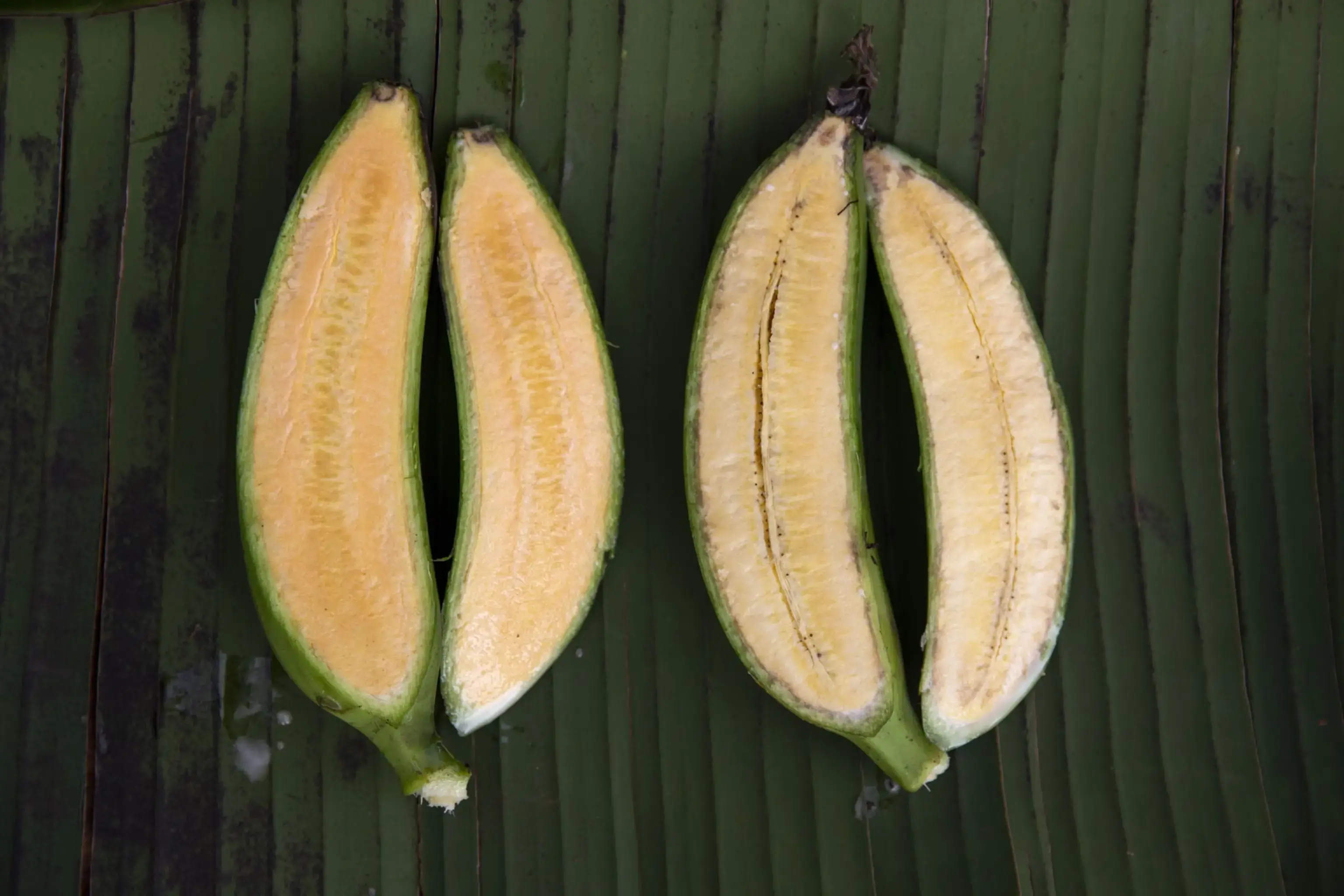
Para ler esta história em português, clique aqui.
Thousands of children die in Uganda every year from vitamin A deficiency. This groundbreaking—and vitamin-packed—genetically modified banana could change that.
KAWANDA, Uganda — Wilberforce Tushemereirwe holds up a genetically modified banana that took millions of dollars and 20 years to make. It contains so much provitamin A, a substance that transforms into vitamin A in the body, that its flesh has a distinctive orange tint.
This “super banana” was created at Uganda's National Agricultural Research Laboratories (NARL) for the noblest of causes: to save the lives of thousands of children who die in Uganda every year from vitamin A deficiency. Scientists have long crossbred banana plants to improve resistance to pests, fungus, or drought. But fortifying bananas to deliver nutrients to humans who eat them is a first.
The breakthrough is the result of a partnership of the lab in Kawanda, where Tushemereirwe serves as director, James Dale, an Australian agricultural scientist and banana expert, and the Bill and Melinda Gates Foundation, which invested $11 million in one of the longest running research projects the foundation has ever undertaken. Wilberforce was 44 in 2005, when work began on Banana21, as the project is known, and is 65 today.

As a nonprofit journalism organization, we depend on your support to fund more than 170 reporting projects every year on critical global and local issues. Donate any amount today to become a Pulitzer Center Champion and receive exclusive benefits!
One hurdle remains: gaining government approval in the face of vocal opposition to genetically modified crops. Legislation to regulate and promote development of GMOs has been in the works in the Ugandan Parliament since the early 2000s but has not yet been signed into law.
Early efforts ineffective
Treatment for vitamin A deficiency has existed for a century, and the ailment has all but disappeared from wealthy nations. Yet it remains a serious global public health problem. The World Health Organization estimates that 190 million preschool children suffer from vitamin A deficiency today, mostly in sub-Saharan Africa and Southeast Asia. It is the leading cause of preventable blindness in children. It also inhibits kids’ growth and so weakens their resistance to illness that many die from treatable diseases such as diarrhea and measles. In Africa alone, the “silent hunger” of rampant malnutrition is to blame for 6 percent of early childhood deaths, and in Uganda, one of the world’s poorest countries, it remains high on the list of health risks.
Tushemereirwe experienced this firsthand. He grew up in the 1960s in a rural village where malnutrition was prevalent, and he fell sick many times. Although his parents were able to get him treated at a local missionary hospital, other children in the village were not so lucky; Tushemereirwe attended his first funeral at age 10. The experience, he tells audiences, remains seared into his memory.
His dream, he told me when I visited his lab last year, is that the new banana “gets accepted, especially in the rural areas.”
A cultural icon to the rescue
The Ugandan government has tried for decades to solve the problem—with limited success. Distribution of vitamin A capsules, for example, worked well in urban areas but failed to reach those most in need in rural areas. Fortifying maize and wheat flour and edible oils with vitamin A to boost nutritional values proved more effective. But those foods are not consumed in large enough amounts to make a meaningful difference.
Bananas, a main staple of the Ugandan diet, seemed a better option. Ninety varieties are grown. The average Ugandan eats about 880 pounds a year. (By comparison, the average American consumes about 27 pounds of bananas yearly.) No other food crop has a comparable reach—and in Uganda, bananas are found virtually everywhere.
Not only are they piled high in open-air markets; they fill the shelves of all kinds of stores, whether a barbershop, a CD reseller, or an internet café. Nearly every farm and home garden grows multiple banana plants. Locals eat them steamed with a pinch of salt, smashed into chicken stew, fried, barbecued, boiled, brewed into wine, distilled into alcohol, or simply peeled for a sweet afternoon snack.
Yet, as with other foods, local bananas have never provided enough provitamin A for a healthy diet. Fortunately, banana varieties naturally rich in provitamin A have long existed elsewhere, and Dale knew where. The Asupina banana, which grows on the island of New Guinea, contains up to 30 times the amount of provitamin A found in the East African highland banana. By isolating the Asupina banana’s phytoene synthase gene—rich in beta carotene, a nutrient the liver converts to vitamin A in the body—Dale knew that gene could be transferred to another banana with better yields and a better taste.
Because the needed gene was inside a banana, the new genetically engineered banana would be made from banana genes, not from genes from animals or other plants—a distinction the team hoped would soften criticism of genetic modification. “We’ve been consuming this bit of DNA and this amount of provitamin A for probably a thousand years without any adverse effects,” Dale said. “These will be bananas made in Uganda, by Ugandans, for Uganda.”
So, while the team in Africa readied their lab and learned how to modify plants in-house, Dale worked in Australia in his lab at the Queensland University of Technology to identify genes that would enhance provitamin A in a banana. The work to find the best performing combination took most of a decade. After initial trials succeeded in 2012, Dale sent two biological constructs with the precious extracted gene on to Uganda, where scientists added it to Uganda’s variety of bananas used for cooking.
When I visited the lab in Kawanda last year, field trials were winding down. Stephen Buah, the field trial manager, showed me rows of 500 banana plants raised in a fenced yard, where two of the most promising cultivars, plus two back-ups, had already been selected. The scientists also had collected all the data needed to prove the bananas safe for human consumption. “Now we are ready,” Buah proudly announced.
By then, the Gates Foundation was packing up to leave. Jim Lorenzen, a Gates senior program officer, said several factors were involved, including “the failure of the Ugandan government to pass a biosafety law that would realistically allow (the bananas) to be deregulated.”
The road to political approval is also difficult
Uganda’s Parliament first passed biosafety legislation in 2017, then a revised version in 2021. But President Yoweri Museveni, who urged that the research take place, has yet to sign it. The legislation is now being revised again.
Monica Musenero, a scientist and Uganda’s minister of science technology and innovation, remains optimistic that the proposed legislation will become law. “We didn’t have a good enough foundation to understand. So we were trying to make a law just to protect ourselves out of fear,” she said, explaining the first version. The revised legislation has been further expanded to include biotechnology as a whole, allowing it not only in agriculture but also in other sectors, such as health care. “Now we have a better grasp of the science, but also, as a nation, we understand better what we want.”
While Uganda waits, Kenya, which borders Uganda’s eastern flank, has ended a decade-long ban on GMO crops—a move that some speculate could end the stalemate in Uganda.
Tushemereirwe blames the delay in Uganda on European NGOs for creating doubts about biotechnology. “It’s only fears of people who have more than enough to eat, and that fear is being transmitted to people who have no food, who are dying of starvation,” he said. “I feel very disappointed and frustrated about the slow political process that is listening more to a small minority of anti-GMO Ugandans who are against the release of provitamin A bananas and not to the science that would have saved children’s lives.”While Uganda waits, Kenya, which borders Uganda’s eastern flank, has ended a decade-long ban on GMO crops.
Though skepticism about the science of GMOs lingers and gets most of the blame, an equally complicating factor is Uganda’s reverence for the banana as a cultural icon. In a word, the banana is sacred. Its presence in the country dates to creation mythology of the 13th century A.D. Fred Wanyu, a Ugandan tribal leader and linguist, says his ancestors considered the banana “the mother of society,” and gave names to each species, personifying it. Many descendants of those ancient strains are grown today, and farmers worry that a new super banana will upend Ugandan banana culture writ large. Even conventional crossbreeding of bananas to improve yields or resistance to pests has at times been blamed for causing older varieties to lose texture and taste.
“People personally come and ask you, ‘Please, I wanted the local one. I don’t want that one. That one is not sweet enough,’ ” says Umar Kityo, a young farmer and agronomist who grows 34 local banana varieties. And he fears that nobody will buy a genetically modified banana that’s orange.
The Food Rights Alliance, a politically active nonprofit and harsh critic of GMOs, also frames the argument as equally cultural and scientific. “We need to understand that while we are manipulating bananas, we are attempting to manipulate our culture,” says Agnes Kirabo, the group’s director.
Saying yes to science
Before leaving Uganda, I traveled to Mukono, about 20 miles from the NARL lab in Kawanda, and met Jane Nansubuga, a rare female landowner, for a walking tour around her plantation. She has experienced her own difficulties growing hybrid mangoes. Yields and taste fell below her expectations, yet she remains open to trying what’s next.
“You can’t say no to science. We are living by science,” Nansubuga said. “So it’s all about trying it out.”
As I sat on her balcony overlooking the endless banana forest blending in with the afternoon mist, she served me a luscious steamed cooking banana with barbecued pork she had cooked over a slow fire. While I tasted the soft and sweet fruit, I thought about what Wanyu, the linguist, had told me a few days before.
Despite his reverence for the ancient strains, Wanyu also believes that if a little piece of banana is added to a sister banana, developing into something better, “I think we will live in a better world.” That’s what many Ugandans wish for as they struggle their way out of malnutrition and extreme poverty.
“Culture is dynamic,” Wanyu said. “Otherwise, we would continue writing on stones.”












